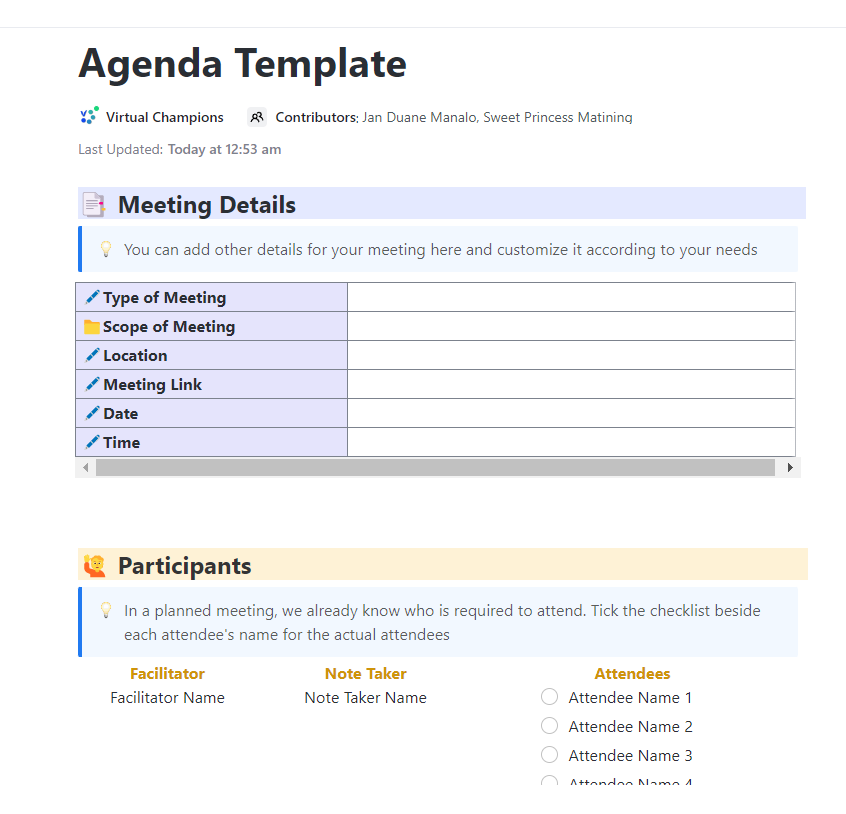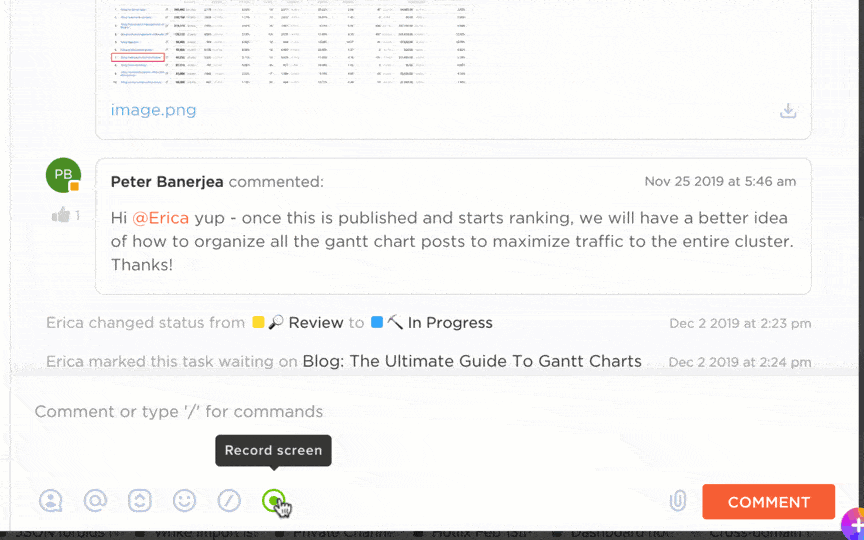How to Master Your First Meeting with a New Team

Sorry, there were no results found for “”
Sorry, there were no results found for “”
Sorry, there were no results found for “”

The first meeting with a new team is a pivotal moment that sets the tone for your relationship with your team.
It’s a chance for you and your team members to build a rapport and start a new and fruitful work relationship. That’s why making a positive and lasting first impression is crucial.
As a new manager, you will work with the team to assign tasks, manage projects, and review performance. The first meeting lets you start on the right foot and do the groundwork for future collaboration.
So, how do you master your first meeting with a new team, and what challenges will you overcome?
Read on to find out.
Meeting a new team is an exciting and challenging experience at the same time. You may be eager to get to know the people you will work with and introduce yourself. However, you may also feel like an outsider trying to get in.
Apart from the jitters and nervousness, there are some other challenges you will need to overcome when having your first meeting. Let’s discuss some of these challenges briefly.
Setting a suitable duration for your first meeting with a new team is challenging. You don’t want to make it so short that people don’t get enough time to interact with you, but you don’t want them to be away from work for too long.
The best way to deal with this is to prepare a clear agenda and assign a duration for each part of the meeting. Set aside some time for Q&A and casual conversations as well.
Add the allotted time slots for each activity or agenda item and calculate the duration. Make sure you keep a buffer in case of unexpected delays.
Once you are done with introductions and you start having regular team meetings, have stand-up meetings of short durations to keep them efficient and on-point.
Did you know that as much as 50% of meetings are unproductive and a waste of time? The most likely culprit for unproductive meetings is not having an agenda.
Not having an agenda can make your meeting directionless and a waste of time for everyone involved. Without a structure, it may go on longer than expected without solving any purpose.
Even your team members wouldn’t know what to expect and would not come prepared. Setting an agenda gives structure to your meeting, making it more efficient and purpose-driven.
Meeting a new team? Set the tone with ClickUp’s Goal-Setting Meeting Agenda Template. Align on shared priorities, spark meaningful conversations, and turn intros into actionable next steps.
If you have a presentation prepared for your first meeting and the meeting space lacks the right equipment, that’s a big problem. Even with the right equipment, technical issues may prevent you from showing a presentation or video.
To avoid such situations, check the equipment and meeting room beforehand and ensure everything works.
If you manage a remote team and plan to have an online meeting, a lot can go wrong. A slow internet connection or a laggy video conferencing solution can make your meeting annoying and inefficient. Use good meeting management software to avoid such issues and ensure your meeting goes smoothly.
One of the biggest challenges you may face when meeting a new team for the first time is not having enough points to discuss with your team members.
Researching and preparing in advance can help with that. You can better converse with your team members if you have a list of talking points and an idea of who’s who.
Otherwise, you may freeze or face awkward silences because of insufficient preparation. So, if you want to make an excellent first impression, attend the meeting well-prepared.
Another challenge you may face when conducting your first meeting is booking a room with the wrong size. This happens when you use an online booking system to book a meeting room without checking it out physically.
Like with technical equipment, you should also check the meeting room beforehand. Make sure that the size is big enough to hold the meeting.
If you have any team activities planned, ensure there is enough physical space and that the meeting room is set up for them.
Another challenge you may face is having too much to say and do during your first meeting with employees and needing more time.
As a new manager, you may have too many things to discuss, but you must learn to prioritize. Remember that the first meeting is introductory; you can schedule work-related meetings later.
Keep things short and interactive instead of trying to achieve too much in one meeting.
One inevitable challenge that most new managers face during a meeting is people getting carried away and having off-topic discussions. Conversations can flow in any direction when you meet a bunch of people in an informal or casual setting.
As a new manager, you must balance informal interactions and an agenda-driven structured meeting. By conveying each agenda item and time, you can steer the meeting in the right direction.
A successful introductory meeting will help you make an excellent first impression on your team and start on the right foot.
But you need the tools and strategies to ensure your first meeting goes well.
Follow the tips below to improve your chances of success further.
Setting an agenda is necessary for every meeting; your first meeting with a new team is no exception. Set goals for the meeting and let your team know the purpose of the meeting.
For a first meeting, the goal should be to introduce yourself and get to know your whole team. However, you should break it down into specific action items and goals to provide more clarity to the attendees.
You will, for example, need:
List all such activities and action items and allocate time for each when planning your first meeting.
Use ClickUp Docs to create a detailed agenda with clear goals and action items. It allows you to create bulleted lists to set goals and use rich formatting to customize your meeting agenda.

If you want to use the next meeting to set team goals, use ClickUp’s Goal Setting Meeting Agenda Template. It is a fully customizable doc with predesigned fields to help you set goals for your new team.
Do not let your first meeting with your team be all about you. Make it an interactive session where team members get to talk to you and get to know you better.
Listen actively to learn more about the team dynamics and individual team members. Pay close attention to each new team member and engage with them.
Pro tip: Learn more about each team member before your first meeting. Read about their roles, accomplishments, and other details from your company’s employee profiles.
This will help you personalize your conversations and engage with each team member while making them feel valued.
Here are some other tips to make your introduction meeting interactive:
When you plan your meeting agenda and action items, leave some time for employee Q&A.
This allows your team members to clarify their doubts regarding how things will work going forward and what’s expected of them. It also helps them get to know you and your management style better.
Leaving time for Q&A is a good practice, even during project meetings. It makes your meetings more interactive and involves everyone in the discussion.
As a manager, you should be prepared for conflicts or disagreements during the first meeting. Anticipate any potential challenges and be prepared for them.
For example, if you plan to change things up and encourage team members to take on new responsibilities, be prepared to face some resistance.
The key is to handle the situation calmly and politely. This is your chance to show your team what kind of a leader you will be. So, anticipate potential issues and be prepared to tackle them head-on.
Prepare talking points to close the meeting properly—ensuring it neither ends abruptly nor trails off awkwardly.
Prepare a short speech to inspire your team and close the meeting positively.
Ensure you set clear next steps and action items for your team before the meeting ends. If needed, schedule one-on-one meetings with team members.
Use AI tools to take meeting notes and summaries and share these with your team members.
The first meeting is only the beginning. You also need to communicate the next steps and plan for future meetings. It helps you understand the team values and get to know your new team members.
While the first meeting is crucial, you can’t possibly achieve everything in one go. You need an action plan and schedule to have regular team meetings.
Let’s discuss some essential aspects you should take care of.
Documenting your meeting and taking minutes is crucial because it helps keep a record of points discussed. People may forget essential action items and next steps if they don’t.
If you’re managing a remote team, recording the meeting becomes even more critical. People can use the recording to reference the points discussed during the meeting.
Use ClickUp Clip to record your first meeting. It allows you to record your screen and create a video recording of your online meeting. This way, team members can hear what was discussed and see your presentation.

Record meeting minutes as easy-to-reference notes and summaries if you want to make things easier. Given the advanced technology available to do the job for you, this can be done without manual effort.
Use ClickUp Brain to auto-generate meeting notes and summaries within seconds, with high accuracy and zero manual effort.

You should also note down action items and next steps for your team members and share them with your team. Use ClickUp’s meeting notes templates with a section for action items and the next steps.
Planning for the next meeting is another critical task you must complete during your first meeting.
Don’t close a meeting without scheduling the next one to check the progress on action items. Create a team meeting schedule and share it with your team to let everyone know how frequently you plan to meet with them.
As a new manager, you should schedule one-on-one sessions with each team member. You will also need to hold project kick-off meetings to discuss various projects and their timelines.
You don’t need to communicate everything during the first meeting. Instead, send a series of emails to convey the schedule for the different types of meetings you plan to hold.
Use the ClickUp next meeting agenda template to set the goals and talking points for your next meeting.
Every manager or team leader’s first meeting with a new team is crucial as it sets the tone for their working relationship with the team.
It’s your chance to make your first impression, introduce yourself to your team, and build trust. If you do it right, you will make a positive first impression, and working with a new team will be much easier for you going forward.
If you manage a remote team and plan to have your first meeting online, ensure you have the tools to make the process seamless.
Use ClickUp Meetings to manage all aspects of your meeting, from setting an agenda to taking notes and conveying the next steps.
Sign up for ClickUp and use it to have a successful meeting.
Here are some talking points you may consider for your first meeting with a new team:
The first thing you should do during your initial meeting is introduce yourself to your new team members. Tell them about your personal and professional background, work experience, and current role.
This is also an excellent chance to set expectations by telling them about your managerial style and how you would lead the team going forward.
You should also thank the team for welcoming you and tell them how much you look forward to collaborating with them.
Start your first team meeting by welcoming everyone and introducing yourself. Use an icebreaker to propel things further. Mention the critical action items planned for the meeting and go through them individually.
© 2025 ClickUp